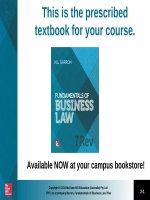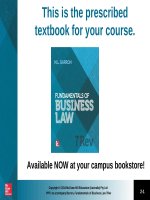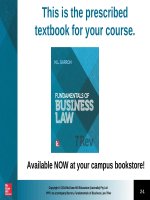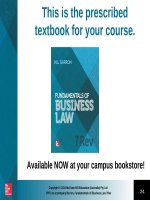- Trang chủ >>
- Thạc sĩ - Cao học >>
- Luật
Lecture Fundamentals of business law (7/e): Chapter 19 - M.L Barron
Bạn đang xem bản rút gọn của tài liệu. Xem và tải ngay bản đầy đủ của tài liệu tại đây (565.61 KB, 27 trang )
This is the prescribed
textbook for your course.
Available NOW at your campus bookstore!
Copyright © 2014 McGraw-Hill Education (Australia) Pty Ltd
PPTs to accompany Barron, Fundamentals of Business Law 7Rev
•2-1
Partnership and joint
venture law
Chapter 19
Copyright © 2014 McGraw-Hill Education (Australia) Pty Ltd
PPTs to accompany Barron, Fundamentals of Business Law 7Rev
•2-2
Learning objectives
At the end of this chapter you should
understand:
•
•
•
•
the definition of the term ‘partnership’
the tests used to decide if partnership exists
how a partnership is created
the matters that should be included in a partnership
agreement
• who has capacity to act as a partner
• the fiduciary nature of a partnership and the obligations
it imposes on partners
• the power of partners to enter into contracts and when
those contracts will bind the partnership
Copyright © 2014 McGraw-Hill Education (Australia) Pty Ltd
PPTs to accompany Barron, Fundamentals of Business Law 7Rev
•2-3
Learning objectives (cont.)
• the liability of partners in contract and tort and the
difference between joint liability and joint and several
liability
• the significance of determining whether a piece of
property is partnership property
• the ways in which a partnership can be dissolved by the
action of the partners and the court
• the characteristics and possible functions of a limited
liability partnership
• the advantages and disadvantages of operating a
business as a partnership
• the definition of the term ‘joint venture’ and how to
distinguish it from ‘partnership’.
Copyright © 2014 McGraw-Hill Education (Australia) Pty Ltd
PPTs to accompany Barron, Fundamentals of Business Law 7Rev
•2-4
Introduction
Partnership:
The carrying on of a business in
common, with a view to making a
profit.
Copyright © 2014 McGraw-Hill Education (Australia) Pty Ltd
PPTs to accompany Barron, Fundamentals of Business Law 7Rev
•2-5
Definitions
• Carrying on a business:
– Continuity or repetition of action to be
carried on in the future
• In common:
– Acting on behalf of each other
• View to a profit:
– Distribution of profits results
Copyright © 2014 McGraw-Hill Education (Australia) Pty Ltd
PPTs to accompany Barron, Fundamentals of Business Law 7Rev
•2-6
Tests for determining the
existence of a partnership
• Common law rules:
– Intention
– Agency
– Sharing of profits and losses
• Statutory rules:
– Joint ownership of property
– Sharing of gross returns
– Receiving a share of the profits
Copyright © 2014 McGraw-Hill Education (Australia) Pty Ltd
PPTs to accompany Barron, Fundamentals of Business Law 7Rev
•2-7
Creation of partnership
• Can be verbal, written or by conduct.
• Written partnership agreement is
desirable as disputes are easier to
resolve.
• Overrides the provisions of the
relevant Partnership Act.
Copyright © 2014 McGraw-Hill Education (Australia) Pty Ltd
PPTs to accompany Barron, Fundamentals of Business Law 7Rev
•2-8
Contents of a standard partnership
agreement
•
•
•
•
•
•
•
•
Names and addresses of
partners and name of firm
Place or places from which
business will operate
Duration of partnership
Capital contribution and
interest of each partner
Share of profits and losses
Salaries paid to partners
Management duties of
each partner
Limitations in authority of
partners
•
•
•
•
•
•
•
•
•
Copyright © 2014 McGraw-Hill Education (Australia) Pty Ltd
PPTs to accompany Barron, Fundamentals of Business Law 7Rev
Details of keeping accounts
Appointment of bankers
Cheque signing
Retirement of partners
Valuing of shares for
retiring/deceased partners
Admittance of new partners
Dissolution of partnership
Competing business setup
Resolving disputes
•2-9
Limits on the size of a partnership
• Number of parties to a partnership
generally must be between 2 and 20.
• For actuaries, medical practitioners and
share brokers or stockbrokers upper limit
is 50.
• For architects, pharmaceutical chemists or
veterinary surgeons upper limit is 100.
• For legal practitioners upper limit is 400.
• For accountants upper limit is 1000.
Copyright © 2014 McGraw-Hill Education (Australia) Pty Ltd
PPTs to accompany Barron, Fundamentals of Business Law 7Rev
•2-10
Who can be a partner?
• Capacity:
– Minors are not liable for partnership debts.
– Mentally incapacitated persons’ liability is
limited if their incapacity is known.
– Bankrupts must disclose bankruptcy.
Copyright © 2014 McGraw-Hill Education (Australia) Pty Ltd
PPTs to accompany Barron, Fundamentals of Business Law 7Rev
•2-11
Relationship between partners
Fiduciary relationship:
• Partners must render true accounts.
• Partners must advise full information on all
matters affecting the partnership.
• Partners must account for private profits made
without consent of other parties.
• Partners cannot carry on a business of the
same nature in competition with the partnership,
without the consent of the other partners.
• Partners may assign their interest in the
partnership to another person.
Copyright © 2014 McGraw-Hill Education (Australia) Pty Ltd
PPTs to accompany Barron, Fundamentals of Business Law 7Rev
•2-12
Relationship between partners
(cont.)
•
Rules regarding the relationship between partners if no
partnership agreement exists:
– All partners are entitled to share equally in capital of the
business.
– All partners are entitled to share equally in profits (and
losses) of the business.
– Partners are entitled to be indemnified by the firm in respect
of payments made and liabilities incurred.
– A partner who makes an advance or payment beyond their
capital contribution is entitled to interest.
– A partner is not entitled to interest on capital subscribed
until profits have been ascertained.
Copyright © 2014 McGraw-Hill Education (Australia) Pty Ltd
PPTs to accompany Barron, Fundamentals of Business Law 7Rev
•2-13
Relationship between partners
(cont.)
– Every partner may take part in the management of the firm.
– No partner will be entitled to remuneration for working in the
partnership business.
– No person will be introduced as a partner without the consent
of all other partners.
– Differences regarding ordinary matters related to the business
of the partnership can be decided by a majority of partners.
– No change can be made to the nature of the partnership
business unless all partners consent.
– The partnership books are to be kept at the place of business
of the partnership.
– Partners cannot be expelled from the partnership.
Copyright © 2014 McGraw-Hill Education (Australia) Pty Ltd
PPTs to accompany Barron, Fundamentals of Business Law 7Rev
•2-14
Relationship of partners to third
parties
• Partners will be bound by each other’s
actions on the basis of an agency
relationship, involving actual and apparent
authority, where:
– the transaction is within the scope of the business
– the transaction has been effected in the usual way
– the third party involved in the transaction either:
knows or believes the partner is acting as a partner
is unaware of any lack of authority to act (includes
non-partner who is believed to be a partner).
Copyright © 2014 McGraw-Hill Education (Australia) Pty Ltd
PPTs to accompany Barron, Fundamentals of Business Law 7Rev
•2-15
Actual and apparent authority
• Actual:
Authority to do acts specified in
Partnership Act or partnership
agreement.
• Apparent (implied):
Authority that the partner appears to
have to third parties, e.g.
– selling goods and chattels of the firm
– purchasing on behalf of the firm.
Copyright © 2014 McGraw-Hill Education (Australia) Pty Ltd
PPTs to accompany Barron, Fundamentals of Business Law 7Rev
•2-16
Liability of partners
•
Contracts—each partner is jointly liable.
•
In tort—each partner is liable jointly and severally.
•
Criminal wrongs—each partner is liable jointly and
severally where there has been a breach of a statute that
does not require intent as an element.
•
In bankruptcy—if a partner is bankrupt, the partnership
may be dissolved.
•
As trustees—no liability for the actions of other partners
acting as trustees independent of the partnership.
•
Holding out as partner—liable as if partner of partnership.
•
Outgoing partner—continues to be liable for debts of
partnership incurred before retirement.
Copyright © 2014 McGraw-Hill Education (Australia) Pty Ltd
PPTs to accompany Barron, Fundamentals of Business Law 7Rev
•2-17
Liability
• Joint liability:
– The partners must be sued jointly and
not individually.
• Joint and several liability:
– Every partner is liable jointly and
individually.
Copyright © 2014 McGraw-Hill Education (Australia) Pty Ltd
PPTs to accompany Barron, Fundamentals of Business Law 7Rev
•2-18
Partnership property
Includes all property brought into the
partnership, or which is afterwards
acquired on account of the partnership.
Copyright © 2014 McGraw-Hill Education (Australia) Pty Ltd
PPTs to accompany Barron, Fundamentals of Business Law 7Rev
•2-19
Dissolution of partnership
• By action of the partners:
– At expiry of time
– By giving notice
– By death of a partner
– By insolvency of a partner
– Where partnership property is charged
Copyright © 2014 McGraw-Hill Education (Australia) Pty Ltd
PPTs to accompany Barron, Fundamentals of Business Law 7Rev
•2-20
Dissolution of partnership (cont.)
By court action when:
• Partner found to be of unsound mind
• Partner becomes permanently incapable of
performing his or her part of the contract
• Partner is found guilty of conduct calculated to
prejudicially affect the carrying on of the business
• Partner persistently breaches partnership agreement
• Partnership business can only be carried on at loss
• There are other just and equitable grounds for
dissolving the partnership.
Copyright © 2014 McGraw-Hill Education (Australia) Pty Ltd
PPTs to accompany Barron, Fundamentals of Business Law 7Rev
•2-21
Notice of dissolution of
partnership
• Personal notice to persons who have had
dealings with the firm
• Notification in government Gazette
• Stationery altered
• Registered business names adjusted at
Corporate Affairs Commission
Copyright © 2014 McGraw-Hill Education (Australia) Pty Ltd
PPTs to accompany Barron, Fundamentals of Business Law 7Rev
•2-22
Distribution of assets at
dissolution of partnership
• Loans from partners
• Creditors satisfied
• Property on basis of contributions of each
party
• Debts and liabilities satisfied
• Surplus assets divided in proportion,
reflecting profit-sharing ratio
Copyright © 2014 McGraw-Hill Education (Australia) Pty Ltd
PPTs to accompany Barron, Fundamentals of Business Law 7Rev
•2-23
Limited liability partnerships
• Legislation in all states permits the
creation of limited liability
partnerships.
• It differs from a conventional
partnership in that it allows a partner’s
liability to be limited to the amount of
their capital contribution.
• Creates two types of partners:
– General partner
– Limited partner
Copyright © 2014 McGraw-Hill Education (Australia) Pty Ltd
PPTs to accompany Barron, Fundamentals of Business Law 7Rev
•2-24
Joint ventures
• An association of persons for the
purposes of a particular trading,
commercial, mining or other financial
undertaking or endeavour, with a view
to mutual profit, e.g.:
– Mining ventures
– Property development
– Entertainment agreements
– Share-farming agreements
Copyright © 2014 McGraw-Hill Education (Australia) Pty Ltd
PPTs to accompany Barron, Fundamentals of Business Law 7Rev
•2-25









